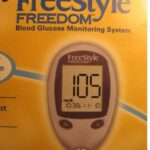The “One Touch Ultrasmart Blood Glucose Monitoring System” is quite a pretentious title for a glucometer. It sounds like ‘hype.’ It’s not. This device is something more than a simple glucometer, although it serves that purpose well and conveniently. And, if that’s all you want from it, it will outperform most of its simpler cousins. That, however, would be a waste of the full potential of this device that provides the capacity for maintaining all of the relevant data necessary to treat diabetes. Not everyone needs the full panoply of functions that this meter provides; but some people do. Fragile, insulin dependent diabetics, particularly children, need a complete record of all things related to their glucose levels and, hence, their requirements for insulin. Managing a fragile, young diabetic, has been (and still is) a daunting task. In the past, it was dependent on guesswork derived from experience of other diabetics. The capability of this meter to record its results and relate them to activity level, exact intake of food (broken down by source of calories), health status, time of day, intake of insulin and any other relevant medications, stress, and other circumstances allows a highly precise titration of treatments tailored to the individual. I cannot emphasize enough the value of this for some fragile diabetics. It allows very good control that might have been virtually impossible to achieve without this information. You can, of course, keep all of these data by hand in a journal and calculate the correlations by hand. You can, but you won’t because it is inconvenient, easy to fudge, and simply a lot of trouble. Very few people actually do maintain records as complete as this machine will help you keep. O.K., that’s an overall introduction to the review; now the review.
The OneTouch Ultrasmart meter itself is a roughly 9 1/2 X 5 X 1 cm. device that fits easily into an adult’s hand. It is made of a lightweight, high impact plastic that has a ‘metalic’ appearance. The front has a 3 1/2 by 4 1/2 cm. backlit screen that’s relatively easy to read. There are five ‘buttons’ on the front marked by symbols for their functions. There is a covered side port for hardwiring to a computer. It conforms comfortably to the palm of a normal sized adult hand. It fits into a case that’s roughly 15 X 11 cm, 3 cm thick. The case accommodates all that is necessary for the functions, a vial of test strips, storage for the lancets and a space for the adjustable lancet device that comes with it. Set up is relatively easy and requires testing the rough calibration of the meter through the use of the vial of test solution that is provided. Each batch of test strips is coded with a number to which you adjust the meter to match. You only need to do that when you change from one coded test strip to a different one. The packages of strips come in twin vials containing 25 strips each, so the most you would have to change the setting on the meter is every 50 strips. This is very easy to do, anyway, but out of some perverse curiosity, I mismatched the strips with the setting on the meter for a number of trials. I did this several times and it made virtually no difference in the readings. If, in their laboratory tests Lifescan (Johnson and Johnson) found the accuracy so high that this small adjustment mattered, I am indeed impressed.
By far the most important single feature of any glucometer, of course, is its accuracy. All meters have some degree of variability in normal use. These come from variations in sampling technique, small variations in the samples themselves, and inherent error variability of the meter. Many popular meters become simply unreliable at certain ranges of blood glucose, usually the high ranges, in which accuracy is vital. I have tested a large number of different meters and this one has been the most reliable and accurate (as measured against laboratory values) I have found. This was true at all the ranges I tested, from (coma level) low concentrations to higher levels than you are likely to deal with in normal use. It does have a lower (20 mg./dL) and an upper (600 mg/dL) range limit, but this is as wide a range as any other portable meter. An additional feature that I appreciated was the fact that it uses the readily obtainable AAA size battery. This is useful for me because I don’t have to worry about having a spare battery that will fit nothing else. I keep more power cells from AAA to D and everything in between than most Radio Shack stores. I don’t like to be caught short.
There is a multilanguage manual included that is worth the trouble to read and, also, a “quick reference guide” for the impatient. The sampling technique is simple and the fact that it requires only a microliter or so of blood to operate allows small wounds and the possible use of sites other than the finger. It yields its results five seconds after the test strip slurps up its tiny sample. It will cue the user to interpret the results by warnings to check ketones at high levels and to eat something at dangerously low levels. In extensive use, with myself and others, I have rarely had any problem in obtaining a valid sample. The error level,with reasonable care in use, is vanishingly small.
I use this meter in my own diabetes monitoring, for the far more sensitive needs of my six year old granddaughter, who is a fragile diabetic, and from time to time, professionally. This is the handiest meter I have ever used and when I want to keep track of any other person’s readings, separately from my own, it is relatively simple to code that into the meter.
When, as in the case of my my granddaughter for purposes of programming her insulin pump, it is useful to keep track of all of the relevant circumstances of each reading, this meter allows (invites) the recording of any food, activity level, health issues, stress, medications (including, of course, insulin) that accompanies each sample. It stores all of this information, collates it, organizes it, and spits it back out to you on request. Thus, you can get a graph of glucose levels through the day, as a function of food intake, as affected by exercise, illnesses, stress levels and immediately allow you to see the effects of any of these variables as reflected over periods of time from hours to weeks. In the case of very fragile diabetics, such as my granddaughter, it allows you to compensate for anything that might affect your glucose levels throughout the day by adjusting doses of medication. And then it will allow you to evaluate the success of your changes. It increases the accuracy by which you can program an insulin pump to maintain proper glucose levels throughout the day and to compensate for times of different need such as holidays or times of unusual activity. The ability to rapidly see what effects different activities, foods, etc., have had on your blood glucose levels without requiring you to analyze a painstakingly kept journal, simply makes it easy and convenient to take proper care of your diabetic problem. In practical terms, it is probably the difference between very accurate and proper care and dangerous guesswork that results from the extreme inconvenience of hand records that often invite cutting corners and estimating. For some people, that difference can be the difference between maintaining good health and serious illness; quite literally, a possible difference of life or death. Is this hyperbole? No, not really. This device, when properly used, can really aid the patient and the healthcare professional make accurate and, sometimes critical, decisions. It is, of course, not necessary for many, or most, diabetic patients. Medication controlled type II diabetes does not require the fine adjustments that this meter can facilitate. If it is just used for an occasional glucose level check, then it isn’t worth the price (about $100.00, retail). After all, manufacturers are so eager for your custom for buying test supplies, particularly test strips, that they will sell you meters for nominal prices. And most of these meters will work well enough to serve the casual user. But even the well controlled adult, type II diabetic can find valuable and extremely interesting information that this little computerized meter/logbook provides. It could lead to lifestyle changes. For example, the discovery of how much stress can affect your health, or how much exercise can help it, might lead to beneficial lifestyle changes. Or so I tell myself in my more expansive moods. It couldn’t hurt.






